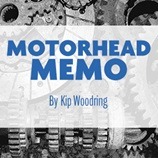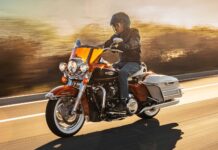
Couple of things we need to get through in the space allotted. Let’s start with the two 114” M-8 engines, one supplied stock or optional and one a Screamin’ Eagle upgrade to the base M-8 engine. As you’d imagine, the two engines have much different characteristics. But deep at heart, the main thing is the stroke… uh… strokes. You wouldn’t think a mere 1/8” was worth getting stirred up about, but in my view the 107” and the 114” version you can make from it are the sweet runners, eager to please and easy to live with.

The longer stroke of the “born” 114” and its 3”- larger 117” is fine… but somehow not as fine. Yeah, I know it’s practically a tenet of the Harley faith to go big or go home, but unless you can make the argument, I’ll stick with the smaller Big Twin…particularly the 114”…especially for Softails! Partly, it’s to do with the fact that both strokes (4 3/8” on 107”/114” and 4 ½” on 114”/117”) use the same rods. Meaning, the longer stroke puts the big end closer to the rim on the latter’s flywheels. That changes rod angularity (or rod ratio, if you prefer), which, in turn, alters how hard the piston pushes against the cylinder wall at certain points in the crank rotation. That tends to be harder on the rings, not least because of the increased force that stops and starts at the top and bottom of each stroke. All else equal, the end result is potentially increased ring wear among other things.

Another factor is that the Stage IV 114” and the Stage IV 117” make comparable average horsepower as well as (critically) torque. The 117” has a slight edge in peak power, but most of us only use peak power about 1 percent of the time. So, the expense and effort involved in getting what H-D reckons as 52 percent more of it from a 107’–114’ conversion also seems a better value than getting 40 percent more from 114’–117’ engines. But… and this is important… with either choice that power comes from cams, throttle bodies, exhaust choices and… mostly heads. Not from cubic inches!

Harley admits it! Yeah, at a recent dealer pow-wow, the subject of head flow somehow came up and the short answer to a long talk is… stock Milwaukee-Eight cylinder heads will not, in fact cannot, match the performance of the CNC-machined Screamin’ Eagle heads. This is because the ports in the stock heads are too big. They did this on purpose.

If you have big ports in a cylinder head, with a so-so valve seating, the head won’t flow as well as it could. Sure, you could port and polish stock heads and increase the cfm. Just don’t confuse air flow rates and air flow volume! Remember, a flow bench measures air flow through an open port at a constant 28″ of water-rated vacuum, yet a running engine has 720 degrees of rotation cycle, during which you might have 230–260 degrees of potential for effective air flow at a constantly-changing vacuum (or pressure) through the valve. At 6300 rpm those valves are opening and closing 53 times a second. So, a given cfm is operating at a fraction of the rating in terms of effective flow. Starting and stopping that column of air (and fuel droplets) many times per second is not conducive to the smooth transfer of the fuel/air medium from the induction system. And it is certainly not supportive of good mixture quality when fuel droplets are violently slammed against the back of the valve at high speed and just as quickly accelerated and flushed past the seat into the cylinder where a whole different pressure environment exists. Meaning… engines run on dynamic velocity… not static cfm airflow numbers.

The real key is to get rapid airflow as equal as possible around the entire circumference of the valve. This… Harley has done with the CNC heads. They are a different casting, with smaller, faster, raised inlet ports feeding 40mm cut-back Ferrea intake valves and poppin’ it out similar 32mm exhausts. Getting stock heads to match what these do would cost more and likely return less…period! Thought you’d want to know. But… that’s not the whole (hole?) story…





















So why did they do it on purpose?
Because there in the business of making money.
Hey, thanks for the great report on the difference between the stock and SE heads. This is the only place that provides the details and reasons for installing the SE heads. Sounds like all of the porting of the stock heads that is offered won’t provide the most important ingredient, flow velocity. Any more details you want to offer on anything to do with the Milwaukee engine would be welcomed.
So, to reiterate, put the Stage IV CNC ported heads on and add the 64mm throttle body to a Stage III kit (107 to 114) for the best performance. Should the larger injectors be installed? Any other suggestions for a normally ridden street bike?
Question on a different subject. When a tuner tunes your bike does the software suggest the changes and how much of getting a good/great result depends on the tuner? How do you know a good tuner from a great one?
1 – Warranty, warranty costs and marketing.
2 – Actually they must make money!
3 – Yup… injectors don’t hurt an can only help. Tires, shocks and brakes… always last thought of and first invoked for “normally ridden” or any other kind of riding, for that matter. (All the power in the world is wasted if it can’t get to the pavement.) The software shows where changes need ot be made and it’s getting more and more “cookie cutter” brainless for tuners all the time. That said… to my mind, the best tuners are the ones that take actual test rides “after” to ensure they got it right for the real world. In other words, there’s more to “tuning” than just computers.